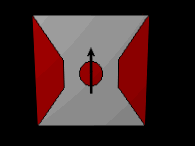
Materials Research Science and Engineering Center: Faculty Publications
Document Type
Article
Date of this Version
1-1-2006
Abstract
This chapter is devoted to the electronic structure of nanoscale metallic magnets. After an introduction to methods of electronic structure calculations, we review how recent trends translate into the description of magnetic nanostructures. Among the considered structures are nanowires, small particles, surfaces and interfaces, and multilayers, and emphasis is on magnetic properties such as moment and magnetization, interatomic exchange, and anisotropy.
One of the goals of computational nanoscience is to calculate physical and chemical properties from first principles. This requires the knowledge of the electronic structures of the materials system in question. The density-functional theory (DFT) makes a huge step towards this goal, by reducing a highly complex many-electron problem to that of noninteracting particles under the influence of an effective potential. The adiabatic approximation allows one to separate the ionic degrees of freedom from those of the electrons. However, in order to apply DFT in practice one has to resort to approximations for electron exchange and correlation such as the local-density approximation (LDA) or the generalized-gradient approximation (GGA). In this chapter, we have outlined some basic principles and some important examples of this approach, representing a very large and growing body of experimental and theoretical work on magnetic nanostructures such as clusters, nanowires, nanocontacts, and multilayers.


Comments
Published in Advanced Magnetic Nanostructures, edited by David J. Sellmyer and Ralph Skomski (Springer, 2006).
http://www.springer.com/east/home/generic/search/results?SGWID=5-40109-22-97856589-0
Copyright © 2006 Springer Verlag. Used by permission.